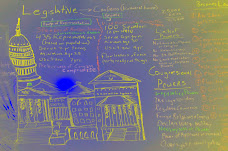Today while looking through the new US history book I am to teach with, I found their discussion of propaganda tucked into the coverage of the American Revolution. Not where I would’ve put it, but appropriate enough. It was not the first time that intentionally misleading promotions and pronouncements in periodicals prodded an American public into a war. Nor was it the last.
As you may recall from your high school journalism class, or from that one crazed social studies teacher who kept imploring you to be less gullible than an Eloi marching blindly into a Morlock cave, there are seven types of propaganda. While Bush boners like the “Healthy Forests Initiative” and “you’re either with us or against us” may have been painfully plain to the liberal among us, Obama might be harder to peg.
Obama did not simply buy his way into the presidency, he talked us into it; even if he did raise seven hundred and fifty million dollars, outspending McCain 2-1 in the homestretch. Clearly Obama made his case with the American people; but his campaign was no less manufactured than McCain, except Obama’s worked. He didn’t talk America into hiring him it by being the anti-politician; he did it by being the best politician the money could buy.
Educational ethics lead me to disclaim that the following list is based on an online handout I stole from Dan McDowell of West Hills High School in Santee, CA, without his foreknowledge, but with his permission and my apology, in the hopes we can all just write this off as educational intellectual freedom in the further hope some of us might learn something.
Barack Obama has worked very hard to appear to all things to all people while campaigning, but now that he is defining himself through his cabinet appointments and press releases; it could be fun for the strong stomached to parse the propaganda factor in Obama’s present pitches. Or it could be distressingly predictable and depressing.
Obama’s propaganda does not protrude as pronouncedly as Bush’s “Mission Accomplished” codpiece, but he’s still got it hanging seven different ways.
APPEAL TO AUTHORITY: Appeals to authority cite prominent figures to supports a position, idea, argument, or course of action.
We’ll start with reminding you of something that you already knew: no one gets into the club unless they are already a member. Oh sure, Obama and McCain competed to see who was the farthest outsider and the most maverick; but most mavericks are out on the range, not in the Hart Senate Office Building. They don’t call the Senate the “Millionaires’ Club” for nothing.
Oh yeah, Obama’s been in there with “the haves and the have mores,” those adorable folks Bush calls his base. We’re talking Bilderbergs, baby. Obama’s been hanging out with them since he got hot, just like Hillary, Robert Gates, Bill Richardson, Larry Summers, Timothy Geithner, and Tom Daschle. You throw in cabinet member memberships in the Council on Foreign Relations and other NWO-type group and you’ve got most of Obama’s people coming from the crowd that produced Bush’s people. I am sure we’re all agreed that those guys are indeed the authorities on how to run a government … straight into the ground.
GLITTERING GENERALITIES: This approach is closely related to what is happening in TRANSFER (see above). Here, a generally accepted virtue is usually employed to stir up favorable emotions. The problem is that these words mean different things to different people and are often manipulated for the propagandists' use. The important thing to remember is that in this technique the propagandist uses these words in a positive sense. They often include words like: democracy, family values (when used positively), rights, civilization, even the word "American."
In the campaign Obama’s greatest strength was that he didn’t give a simple answer. Even his shorter remarks were built on specifics. In politics that is often mistaken for telling the truth. Now of course, President –elect Obama is happy to speak in generalities. For example, on Obama’s change.gov website, in his Friday 12/5 speech, which addresses the half a million jobs lost last month alone, among the over two million this year, Obama promises “to put people back to work and get our economy moving again.”
Good thing we didn’t elect the other guy. He probably wouldn’t have thought of those kinds of things. (OK, knowing McCain, maybe not.)
BANDWAGON: The basic idea behind the bandwagon approach is just that, "getting on the bandwagon." Either everyone is doing it or supporting this person or cause, so you should too. The bandwagon approach appeals to the conformist in all of us: No one wants to be left out of what is perceived to be a popular trend.
Do you have your Obama plate? Everybody wants one. You don’t want to be the heretic who doesn’t love him enough to collect plastic crap for him, do you?
TESTIMONIAL: This is the endorsement of a philosophy, movement or candidate. While celebrities are usually used, it can be people who supposedly "know" about the topic or situation.
Unfortunately for some of us, many of the people who have lately taken to endorsing Obama are actually far scarier than Rev. Wright or Bill Ayers ever were. When Karl Rove cup of Thanksgiving cheer includes a WSJ editorial praising Obama, you know he isn’t in the same party as Kucinich anymore. These days Obama’s looking so Republican even GOP hard-line pundit David Horowitz has taken to fronting for him.
PLAIN FOLKS: Here the candidate or cause is identified with common people from everyday walks of life. The idea is to make the candidate/cause come off as grassroots, all-American, for the common man.
Obama photo-ops are a clear winner in this field. It is probably not even possible to take this image any further of being a man of the common earth than the now iconic pic of Obama’s feet propped up revealing his soles worn through.
TRANSFER: Transfer employs the use of symbols, quotes or the images of famous people to convey a message not necessarily associated with them. In the use of transfer, the posters attempt to persuade us through the indirect use of something we respect, such as a patriotic or religious image, to promote specific ideas.
As Daily Show’s Jon Stewart justly chortles, Obama’s bunting bill is more getting obscene than the GOP Styrofoam fake straw hat bill. No less than five flags flank the dauphin as he makes pronouncements these days. That’ll teach you, lapel flag flakes, who is the REAL patriot.
FEAR: This technique is very popular during wartime. The idea is to present a dreaded circumstance and usually follow it up with the kind of behavior needed to avoid that horrible event.
Wanna create some fear? Start here: All the Robert Rubin acolytes given high positions of power did not help many Americans feel warm and fuzzy. During the campaign Obama rightly slammed McCain as wrong on deregulation, but now he’s advancing the same kinds of people? When the audience commented on what appeared to be smoke and mirrors in selling repackaged Clinton Redux as “Change,” the Obama reaction was swift and reminiscent of the way Ari Fleischer used to do such a heck of a job reminding folks they should watch their step for being too liberal. Now Obama’s got Steven Hildebrandt to do it for him.
Keeping the theme going, recent admissions reveal the Obama “Take America Back for the American People” plan has already lost its crowd pleasing components of taxing the rich and windfall oil profits. Oops, there goes some of that populous luster. And how about this James Ramstad, the proposed “Drug Czar”? No wonder they call the position “Drug Czar.” The guy is charge of a Gulag the size of Siberia, and Ramstad seemed intent on keeping it that way.
Remember the Yes Men’s faux New York Times edition, where an Obama admin would be a liberal’s dream come true? Well, for this one liberal the dream is coming nightmare: that I’ll wake up in ’09 and it will be ’02 again.
--mikel weisser writes from the left coast of AZ.
Subscribe to:
Post Comments (Atom)










No comments:
Post a Comment